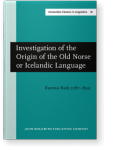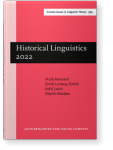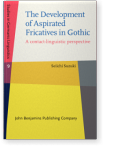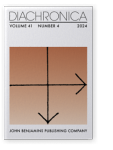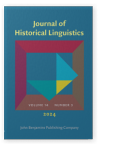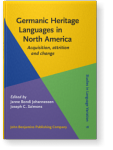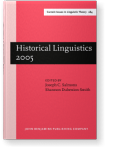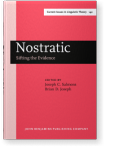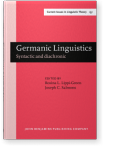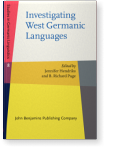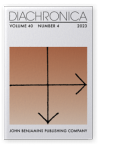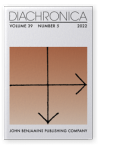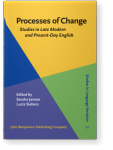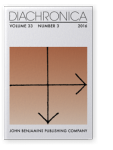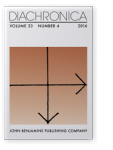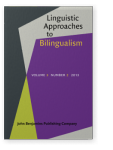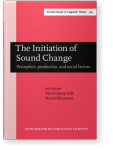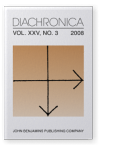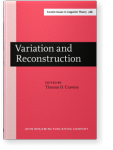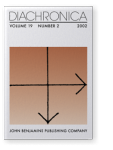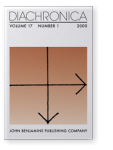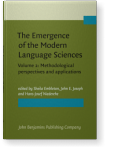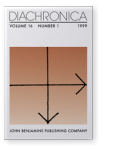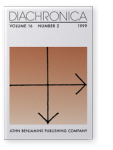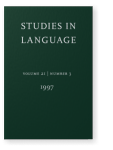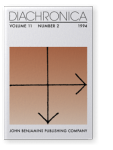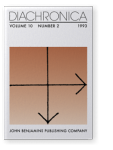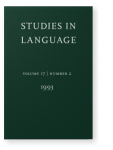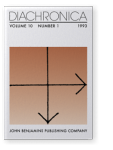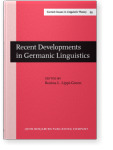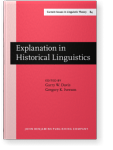Joseph C. Salmons
List of John Benjamins publications for which Joseph C. Salmons plays a role.
Book series
Journals
ISSN 2210-2116 | E-ISSN 2210-2124
Germanic Heritage Languages in North America: Acquisition, attrition and change
Edited by Janne Bondi Johannessen † and Joseph C. Salmons
[Studies in Language Variation, 18] 2015. vi, 418 pp.
Subjects Germanic linguistics | Historical linguistics | Sociolinguistics and Dialectology | Theoretical linguistics
Historical Linguistics 2005: Selected papers from the 17th International Conference on Historical Linguistics, Madison, Wisconsin, 31 July - 5 August 2005
Edited by Joseph C. Salmons and Shannon Dubenion-Smith
[Current Issues in Linguistic Theory, 284] 2007. viii, 413 pp.
Subjects Historical linguistics
Diachronica 1984–1998: Index to Volumes I–XV
Compiled by David J. Holsinger
[Diachronica, 17:IND] 2000. vi, 66 pp.
Subjects Historical linguistics
Nostratic: Sifting the Evidence
Edited by Joseph C. Salmons and Brian D. Joseph
[Current Issues in Linguistic Theory, 142] 1998. vi, 293 pp.
Subjects Historical linguistics
Germanic Linguistics: Syntactic and diachronic
Edited by Rosina L. Lippi-Green and Joseph C. Salmons
[Current Issues in Linguistic Theory, 137] 1996. viii, 192 pp.
Subjects Germanic linguistics | Historical linguistics | Theoretical linguistics
2025 日本言語政策学会 / Japan Association for Language Policy. 言語政策 / Language
Policy 10. 2014 Historical Linguistics 2022: Selected papers from the 25th International Conference on Historical Linguistics, Oxford, 1–5 August 2022, Kennard, Holly, Emily Lindsay-Smith, Aditi Lahiri and Martin Maiden (eds.), pp. 79–93 | Chapter
Policy 10. 2014 Historical Linguistics 2022: Selected papers from the 25th International Conference on Historical Linguistics, Oxford, 1–5 August 2022, Kennard, Holly, Emily Lindsay-Smith, Aditi Lahiri and Martin Maiden (eds.), pp. 79–93 | Chapter
The last broad assessment of Algonquian internal relationships was over a quarter century ago, by Goddard (1994), and most research since adopts his view that the relationships almost entirely reflect an areal cline rather than subgroups, though that consensus may be beginning to break down.… read more
2024 An excursion into the lost history of historical sociolinguistics Investigating West Germanic Languages: Studies in honor of Robert B. Howell, Hendriks, Jennifer and B. Richard Page (eds.), pp. 301–324 | Chapter
An origin story has emerged and solidified around the relatively new research area called historical sociolinguistics – a story based primarily on the field’s relatively brief history as a “named” field (reaching back only a few decades) and repeated regularly and largely uniformly in summary,… read more
2023 Diachrony and Diachronica: 40@40 Diachronica 40:4, pp. 557–568 | Editorial
2022 Ernst Frideryk Konrad Koerner: In memoriam Diachronica 39:5, pp. 613–615 | Miscellaneous
2019 Chapter 7. Early immigrant English: Midwestern English before the dust settled Processes of Change: Studies in Late Modern and Present-Day English, Jansen, Sandra and Lucia Siebers (eds.), pp. 115–138 | Chapter
We explore the development of final obstruent neutralization (German Bad ‘bath’: /ba:d/ = [ba:t]) and other features of an emerging Wisconsin English variety that has been shaped by contact, while considering multiple factors such as input, contact, and influence from other varieties. We draw our… read more
2016 Joe’s jotting Diachronica 33:4, pp. 547–550 | Editorial
2015 Heritage Language Obstruent Phonetics and Phonology: American Norwegian and Norwegian-American English Germanic Heritage Languages in North America: Acquisition, attrition and change, Johannessen, Janne Bondi † and Joseph C. Salmons (eds.), pp. 97–116 | Article
This chapter explores the acoustics and phonology of speech sounds produced by Norwegian heritage speakers in the Upper Midwest in Norwegian and to a lesser extent in English. The study reports work on acoustic differences in obstruents spoken by heritage speakers whose L1 and L2 are both… read more
2015 The study of Germanic heritage languages in the Americas Germanic Heritage Languages in North America: Acquisition, attrition and change, Johannessen, Janne Bondi † and Joseph C. Salmons (eds.), pp. 1–18 | Article
2013
This paper reports initial findings on the apparent loss of passive voice constructions in Moundridge Schweitzer German, a moribund enclave dialect spoken in South Central Kansas. The dialect once had three agent-suppressing constructions; today speakers produce only an impersonal construction but… read more
2012 Quantifying the evolutionary dynamics of German verbs Journal of Historical Linguistics 2:2, pp. 153–172 | Article
Notions of constant rates of language change, whether relative or absolute, are widespread but controversial. Lieberman et al. (2007: 713) posit a frequency-based principle for verb regularization, tested against English historical data: “a verb that is 100 times less frequent regularizes 10 times… read more
2012 Prosodic skewing of input and the initiation of cross-generational sound change The Initiation of Sound Change: Perception, production, and social factors, Solé, Maria-Josep and Daniel Recasens (eds.), pp. 167–184 | Article
This paper addresses a proposal about how the seeds of sound change are planted during cross-generational transmission in the particular case of persevering vocalic chain shifts, that is, changes that appear to span many generations. Specifically, we explore the idea that the realization of vowels… read more
2008
Historical Phonology and Evolutionary Phonology
Diachronica 25:3, pp. 411–430 | Review article2006 Reconstructing variation at shallow time depths: The historical phonetics of 19th century German dialects in the U.S. Variation and Reconstruction, Cravens, Thomas D. (ed.), pp. 37–58 | Article
2002 Joe’s Jottings Diachronica 19:2, pp. 429–430 | Miscellaneous
2000 Review of Green (1998): Language and History in the Early Germanic World Diachronica 17:1, pp. 161–165 | Review
1999 37. Toward “a Complete Analysis of the Residues”: On regular vs. morpholexical approaches to OHG umlaut The Emergence of the Modern Language Sciences: Studies on the transition from historical-comparative to structural linguistics in honour of E.F.K. Koerner, Embleton, Sheila, John E. Joseph and Hans-Josef Niederehe (eds.), pp. 239–254 | Article
1999 Publications Received/Ouvrages Reçus/Eingegangene Schriften Diachronica 16:1, pp. 217–232 | Miscellaneous
1999 Publications Received/Ouvrages Reçus/Eingegangene Schriften Diachronica 16:2, pp. 413–431 | Section header
1998 Introduction Nostratic: Sifting the Evidence, Salmons, Joseph C. and Brian D. Joseph (eds.), pp. 1–12 | Chapter
1997 Prosodic Templates in Sound Change Diachronica 14:1, pp. 31–66 | Article
SUMMARY Prosodic Morphology and Phonology have extended the prosodic hierarchy to solve recalcitrant problems in a number of areas and, more recently, work on phonological acquisition has determined that a prosodic template is a basic organizing unit for the acquisition of features and… read more
1997 Beard, Robert. Lexeme-Morpheme Base Morphology Studies in Language 21:3, pp. 709–711 | Squib
1996 Foreword Germanic Linguistics: Syntactic and diachronic, Lippi-Green, Rosina L. and Joseph C. Salmons (eds.), pp. vii–viii | Foreword
1994 Umlaut and Plurality in Old High German: Some Problems with a Natural Morphology Account Diachronica 11:2, pp. 213–229 | Article
SUMMARY This article examines the interplay between umlaut and plurality in Old High German as well as the modern language, a diachronic problem central to the theoretical literature on 'Natural Morphology' (NM). The NM analysis of these relations is revised on a variety of theoretical and… read more
1993 Review of Voyles (1992): Early Germanic Grammar: Pre-, Proto-, and Post-Germanic Languages Diachronica 10:2, pp. 291–294 | Review
1993 The Structure of the Lexicon: Evidence from German Gender Assignment Studies in Language 17:2, pp. 411–435 | Article
Data from language acquisition, psycholinguistics, and diachronic studies have all shown that the lexicon has a clear internal structure, which includes relationships among lexical items based on phonetic and phonological characteristics, semantic features, morphology, and frequency of use. In the… read more
1993 Gothic PL- ~ FL- Variation as Lexical Diffusion Diachronica 10:1, pp. 87–96 | Article
1992 The Evolution of Gender Assignment from OHG to NHG Recent Developments in Germanic Linguistics, Lippi-Green, Rosina L. (ed.), pp. 81–96 | Article
1992 A look at the data for a global etymology: *tik ‘finger’ Explanation in Historical Linguistics, Davis, Garry W. and Gregory Iverson (eds.), pp. 207–228 | Article
